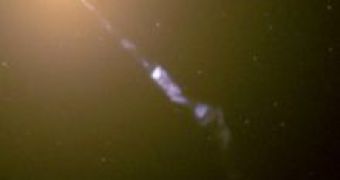One mystery about how there can be so many stars has now grown bigger - astronomers have found that in the early universe, stars have had a very low birth rate. The number of stars born today out of the gas that fills the interstellar space in our galaxy is of only a few stars each year. At this rate of formation, the stars we see, about 400 billion in the Milky Way alone, wouldn't have had enough time to appear since the Big Bang. So, astronomers assumed that in the earlier universe, the stellar birth rate was higher.
However, astronomers from Yale and Leiden University in The Netherlands using the 8.1m Gemini telescope in Chile have now reported that many of the largest galaxies in the Universe had a very low stellar birth rate even when the Universe was only about 20 percent of its present age. To account for this, they push the high-birth rate formation even further back in time.
"Our new results imply that the stars in many large galaxies were born when the Universe was in its infancy, in the first few billion years after the Big Bang," said team leader Mariska Kriek, a PhD student from Leiden University and Yale. "The results confirm what some astronomers had suspected -- galaxies seem to have some method of 'birth control' that is very effective." So, they have to assume a very vigorous period of galaxy and star formation that then slowed down. "These [early] galaxies had a very violent early youth, but rose into stable adulthood well before many galaxies like the Milky Way were even in kindergarten," said Kriek.
Scientists used the very powerful Gemini Near Infrared Spectrograph to analyze the light from galaxies so far away that it had been traveling for nearly 11 billion years, or 80 percent of the age of the Universe. Because each element has a certain unique spectral "signature", the spectral analysis allows astronomers to determine what kind of atoms have been present in those galaxies and in what proportions.
"The unexpected finding is what was not found - we expected to see a prominent signal from ionized Hydrogen, the tell-tale signature of star birth," explained Pieter van Dokkum, associate professor of astronomy and physics at Yale University. "Remarkably, for nine of the twenty galaxies that we observed, this signature is not seen at all. It gives a firm limit on the stellar birth rate in these objects."
They speculate that the low stellar birth is due to the presence of black holes. The dust and gas that would have coalesced into new stars is being sucked by the enormous black holes in the centers of large galaxies. Moreover, when material spirals into a black hole, it is accelerated and as a result, huge amounts of energy are released. These energetic jets may dilute the gas sufficiently to prevent future star birth.
"Evidence for the presence of these black holes is seen in several of the galaxies studied, lending support to the idea that black holes serve as cosmic contraceptives in the young Universe," said van Dokkum.

 14 DAY TRIAL //
14 DAY TRIAL //